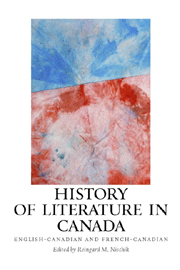Book contents
- Frontmatter
- Contents
- Acknowledgments
- Introduction: Writing a History of Literature in Canada
- I Beginnings
- 1 Aboriginal Oral Traditions
- 2 The Whites Arrive: White Writing before Canada, 1000–1600
- II The Literature of New France, 1604–1760
- III The Literature of British Canada, 1763–1867
- IV From the Dominion to the Territorial Completion of the Nation, 1867–1918
- V The Modern Period, 1918–1967
- VI Literature from 1967 to the Present
- Further Reading
- Notes on the Contributors
- Index
1 - Aboriginal Oral Traditions
from I - Beginnings
Published online by Cambridge University Press: 12 September 2012
- Frontmatter
- Contents
- Acknowledgments
- Introduction: Writing a History of Literature in Canada
- I Beginnings
- 1 Aboriginal Oral Traditions
- 2 The Whites Arrive: White Writing before Canada, 1000–1600
- II The Literature of New France, 1604–1760
- III The Literature of British Canada, 1763–1867
- IV From the Dominion to the Territorial Completion of the Nation, 1867–1918
- V The Modern Period, 1918–1967
- VI Literature from 1967 to the Present
- Further Reading
- Notes on the Contributors
- Index
Summary
AS RENDERED IN THE HAU-DE-NO-SAU-NEE (Iroquois) creation story, the earth came into being when First Woman fell down from the sky world into the water world. In an attempt to break her fall, loons placed themselves beneath her, while the sea animals — duck, otter, beaver, serpent, toad, and muskrat — dived to the bottom of the sea for a piece of mud to create a place for her to land on. After several attempts they succeeded, and the little clump of earth on Great Turtle's back where First Woman safely landed began to grow and expand. Today, the earth still rests on Great Turtle's back.
While this and similar Aboriginal creation stories in their collaborative notion of creation clearly differ from the Western biblical creation account, they bear certain analogies to the early explorers' impressions and accounts upon encountering the North American continent, inasmuch as the land mass indeed appeared at first sight to surface from the vastness of the Atlantic Ocean. More importantly, however, such creation stories claim that North America's Native people originated in North America and have always lived there. They thus contest the Bering Strait Theory, which holds that North America's indigenous population migrated onto the continent from Asia via Alaska over a prehistoric land bridge approximately twenty thousand years ago. Instead, these narratives underline Aboriginal primacy and Native peoples' close and inseparable ties to the land which in their view they are meant to live on.
- Type
- Chapter
- Information
- History of Literature in CanadaEnglish-Canadian and French-Canadian, pp. 27 - 37Publisher: Boydell & BrewerPrint publication year: 2008

